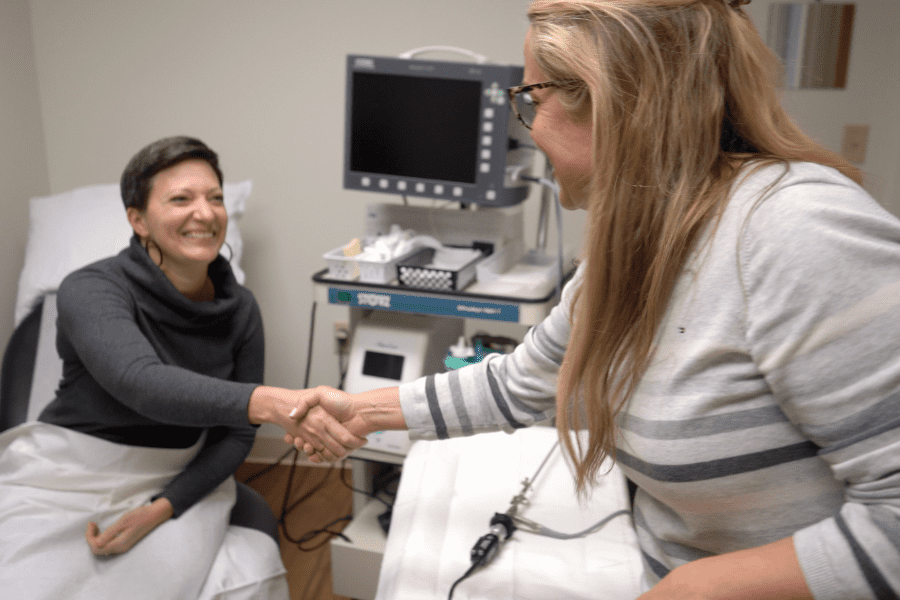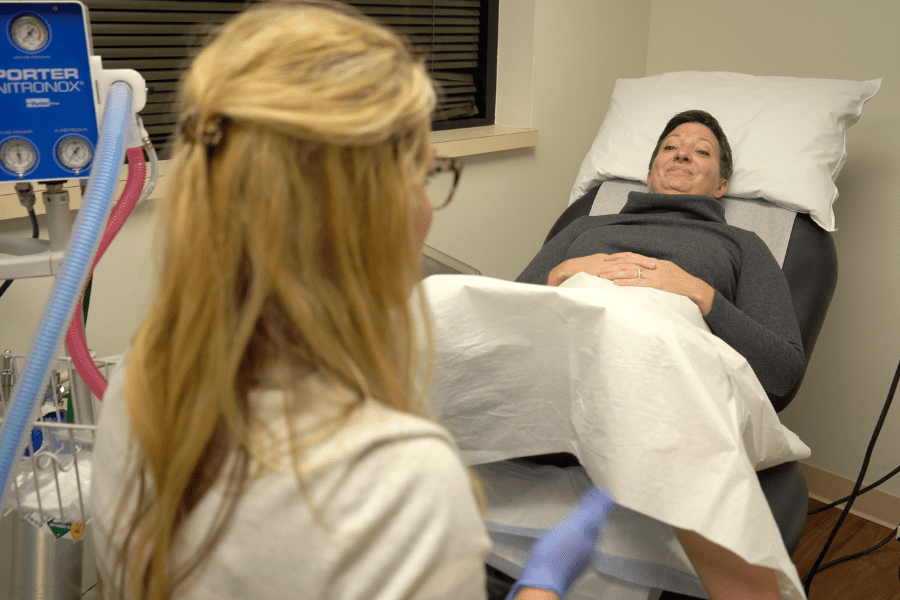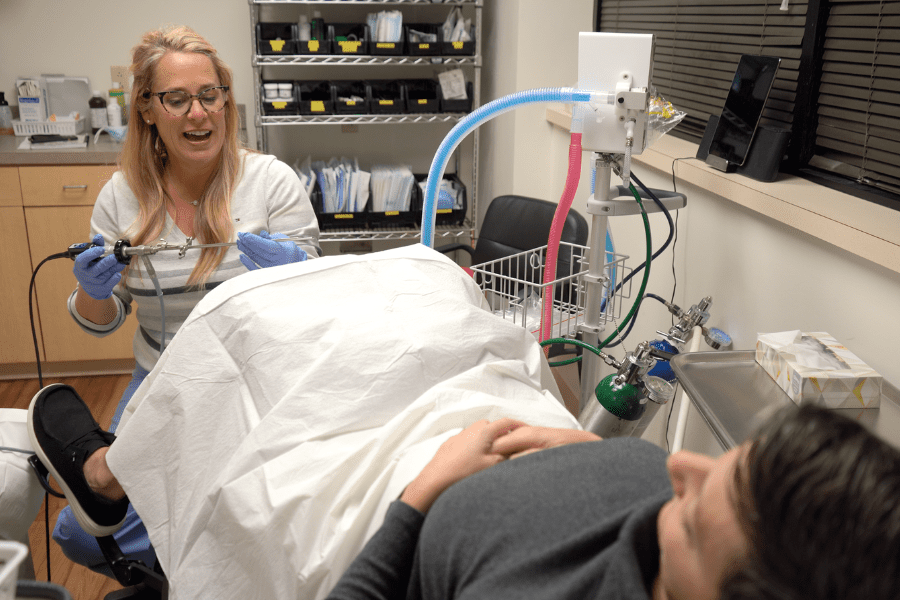Many women don’t talk about urinary frequency and the urgent urge to empty your bladder. However, overactive bladder syndrome (OAB) affects more than 20% of women in the United States. For these women, the inconvenience of being constantly plagued by the urge to go to the restroom is frustrating.
Fortunately, there is a treatment available called bladder Botox. Leigh T. regularly has the bladder Botox procedure with Kelli Miller, M.D., FACOG, and said, “The biggest benefit it has for me is quality of life.”
What is OAB?
 Overactive bladder (OAB) is a condition in which the bladder muscle contracts involuntarily, causing a sudden and urgent need to urinate, often accompanied by urinary frequency and incontinence. In women, OAB is a common condition and can significantly affect their quality of life, particularly as they age. But for Leigh, these issues started early in her life. She says, “Ever since I was a teenager, I had some incontinence with the need to use the restroom frequently.”
Overactive bladder (OAB) is a condition in which the bladder muscle contracts involuntarily, causing a sudden and urgent need to urinate, often accompanied by urinary frequency and incontinence. In women, OAB is a common condition and can significantly affect their quality of life, particularly as they age. But for Leigh, these issues started early in her life. She says, “Ever since I was a teenager, I had some incontinence with the need to use the restroom frequently.”
The exact cause of OAB is unknown, but it may be related to problems with communication between the bladder and the brain. Other factors contributing to OAB in women include hormonal changes during menopause, urinary tract infections, pelvic organ prolapse, obesity, and certain medications.
Symptoms of OAB in women include:
- A sudden and intense urge to urinate that is difficult to control
- The need to urinate more often than usual, typically more than eight times in 24 hours
- Accidental leakage of urine, either during the day or at night
If you live with an overactive bladder, keeping one eye on the location of the restroom is just a normal part of life. The sudden, strong urge to urinate can cause anxiety and embarrassment, especially in social situations where bathroom access may be limited. Incontinence or the involuntary loss of urine, may occur. OAB even causes sleep disturbances. Sleeping through the night is unlikely, leading to fatigue and a decreased quality of life. These symptoms can lead to anxiety, depression, and social isolation.
Traditional treatment for OAB in women may include lifestyle changes, such as reducing fluid intake and avoiding bladder irritants, pelvic floor exercises and medications. One effective medication is a treatment known as bladder Botox. Leigh’s treatment with bladder Botox significantly impacted her life. She says, “The biggest thing I don’t have to do anymore is know where the bathroom is.”
What is Bladder Botox?
 You’ve heard of Botox for cosmetic reasons. Bladder Botox, also known as OnabotulinumtoxinA, is a medical treatment used to manage the symptoms of overactive bladder (OAB) in adults. Botox is a type of neurotoxin derived from the bacterium Clostridium botulinum. When injected into the bladder muscle, it works by blocking the release of a neurotransmitter called acetylcholine, which signals the bladder muscles to contract.
You’ve heard of Botox for cosmetic reasons. Bladder Botox, also known as OnabotulinumtoxinA, is a medical treatment used to manage the symptoms of overactive bladder (OAB) in adults. Botox is a type of neurotoxin derived from the bacterium Clostridium botulinum. When injected into the bladder muscle, it works by blocking the release of a neurotransmitter called acetylcholine, which signals the bladder muscles to contract.
By temporarily paralyzing the bladder muscle, Botox injections can help to reduce the symptoms of OAB, including urgency, frequency, and incontinence. Bladder Botox is reserved for patients who have not responded to other treatments, such as medications or behavioral therapies.
Leigh describes the effects of bladder Botox on her lifestyle as overwhelmingly positive. She says the treatment gives her “the ability to walk into a store and not have to know where the restroom is. That’s huge. If you’re running from store to store or even at work and you’re going into a meeting, I don’t always have to rush to the restroom and make sure I have time before the meeting starts. I don’t have to go every hour.”
This minimally invasive bladder Botox procedure can be performed in a doctor’s office under local anesthesia or light sedation. A cystoscope, a thin tube with a camera, is inserted into the bladder through the urethra, and Botox is injected into several areas of the bladder muscle. The procedure usually takes around 30 minutes, and patients can typically return to normal activities the same day.
The effects of Botox on the bladder muscle usually last for several months, after which the injections may need to repeat to maintain the benefits. Like any medical procedure, bladder Botox carries some risks, including urinary tract infections, difficulty urinating, and allergic reactions. If you are considering bladder Botox, discussing the potential risks and benefits with your healthcare provider is important.
Leigh often recommends bladder Botox to her friends, who, as they age, have begun experiencing OAB. She says, “I explain how simple the procedure is and how quickly the benefits go into effect and how infrequently I have to have it done and just how wonderful it is.”
Are You a Candidate for Bladder Botox?
 Bladder Botox may be an option if you have OAB that hasn’t responded to other treatments, including lifestyle modifications, bladder training, or medications. The benefits of bladder Botox injections include:
Bladder Botox may be an option if you have OAB that hasn’t responded to other treatments, including lifestyle modifications, bladder training, or medications. The benefits of bladder Botox injections include:
- Improved bladder control and a decrease in the urge and frequency of urination
- Reduced frequency and severity of incontinence
- Bladder Botox injections improve bladder function
- Safe procedure with a low risk of serious complications
- Improved quality of life allowing you to engage in social activities, travel, and perform daily activities without interruptions
It is important to note that the benefits of bladder Botox injections may vary from person to person, and the treatment may not be appropriate for everyone. Your healthcare provider will evaluate your situation to determine if bladder Botox injections are an appropriate treatment option.
For Leigh, bladder Botox changed her life. She says, “Dr. Miller’s team is super delightful. The nurses that help you get ready are calm and relaxed and prepared, and then Dr. Miller comes in, and she’s just a joy to be around. I have a lot of friends around my age that are starting to experience these issues. I often tell them what a wonderful experience I have at this practice with Dr. Miller and her team.”
